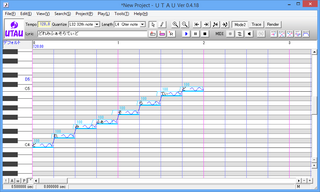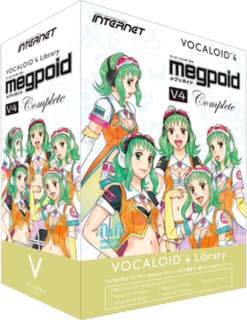
Vocaloid is a singing voice synthesizer software product. Its signal processing part was developed through a joint research project led by Kenmochi Hideki at the Pompeu Fabra University in Barcelona, Spain, in 2000 and was not originally intended to be a full commercial project. Backed by the Yamaha Corporation, it developed the software into the commercial product "Vocaloid" that was released in 2004.

Hatsune Miku, also called Miku Hatsune, and officially code-named CV01, is a Vocaloid software voicebank developed by Crypton Future Media and its official anthropomorphic mascot character, a 16-year-old girl with long, turquoise twintails. Miku's personification has been marketed as a virtual idol, and has performed at live virtual concerts onstage as an animated projection.

Kaito is a Vocaloid developed by Yamaha Corporation. He has performed at live concerts onstage as an animated projection along with Crypton Future Media's other Vocaloids. His production code name was "Taro". His voice is sampled by Naoto Fūga. He was the fifth ever released Vocaloid and the second in Japanese.

Megurine Luka, codenamed "CV03", is a Vocaloid software developed by Crypton Future Media, headquartered in Sapporo, Japan. Its official moe anthropomorphism is a 20-year-old woman. She uses Yamaha Corporation's Vocaloid 2 and Vocaloid 4 singing synthesizer technology. Her voice is sampled from Yū Asakawa. She has performed alongside other Vocaloids at live concerts onstage as an animated hologram projection.
Crypton Future Media, Inc., or simply Crypton, is a Japanese media company based in Sapporo, Japan. It develops, imports, and sells products for music, such as sound generator software, sampling CDs and DVDs, and sound effect and background music libraries. The company also provides services of online shopping, online community, and mobile content.

UTAU is a Japanese singing synthesizer application created by Ameya/Ayame (飴屋/菖蒲). This program is similar to the VOCALOID software, with the difference being it is shareware instead of under a third party licensing.
Zero-G is a company developing sound libraries, sound effects and loops. The company also develops singing synthesizers using the Vocaloid engine developed by Yamaha Corporation.
Vocaloid is a singing voice synthesizer and the first engine released in the Vocaloid series. It was succeeded by Vocaloid 2. This version was made to be able to sing both English and Japanese.

Vocaloid 2 is a singing voice synthesizer and the successor to the Vocaloid voice synthesizer application by Yamaha. Unlike the first engine, Vocaloid 2 based its output on vocal samples, rather than voice analysis. The synthesis engine and the user interface were completely revamped, with Japanese Vocaloids possessing a Japanese interface, as opposed to the previous version, which used English for both versions. It is noteworthy for introducing the popular character Hatsune Miku.

Vocaloid 3 is a singing voice synthesizer and successor to Vocaloid 2 in the Vocaloid series. This version of the software is a much more expansive version, containing many new features, three new languages and many more vocals than past software versions combined.

Vocaloid 4 is a singing voice synthesizer and successor to Vocaloid 3 in the Vocaloid series.

Kagamine Rin & Len, officially code-named CV02, are a pair of Vocaloid software developed by Crypton Future Media, headquartered in Sapporo, Japan. Their official moe anthropomorphism consists of a pair of twin vocals, a boy and a girl both age 14 years old, respectively named Len and Rin. They use Yamaha Corporation's Vocaloid 2 and Vocaloid 4 singing synthesizing technology. Their voices are sampled by Asami Shimoda. They have performed at live concerts together, as they are each other's mirror image.

Megpoid is a Vocaloid by Internet Co., Ltd. Her voice is sampled by Megumi Nakajima. The mascot of the software is called Gumi . She is also sometimes called Megpoid GUMI, or GUMI Megpoid.

Sonika is a female Vocal released for the Vocaloid 2 software by Zero-G Ltd.

Avanna is a Celtic themed female Vocal released for the Vocaloid 3 software by Zero-G Ltd. Her most notable use was by Porter Robinson in the Worlds album, where she was used for several songs including "Sad Machine".

Dex is a masculine vocal developed for Vocaloid 4 by Zero-G Ltd and the male counterpart to fellow female vocal Daina. The voice sampled for Dex was " Kenji-B", a western Vocaloid producer who had helped with many pre-release promotions and development.

Daina is a female vocal developed for Vocaloid 4 by Zero-G Ltd and the female counterpart to fellow male vocal Dex. The voice sampled for her vocal was Vocaloid producer and illustrator "AkiGlancy", who previously had done the artwork for Avanna.

Tonio is a Classical style male vocal developed by Zero-G Ltd and released for the VOCALOID2 engine.















